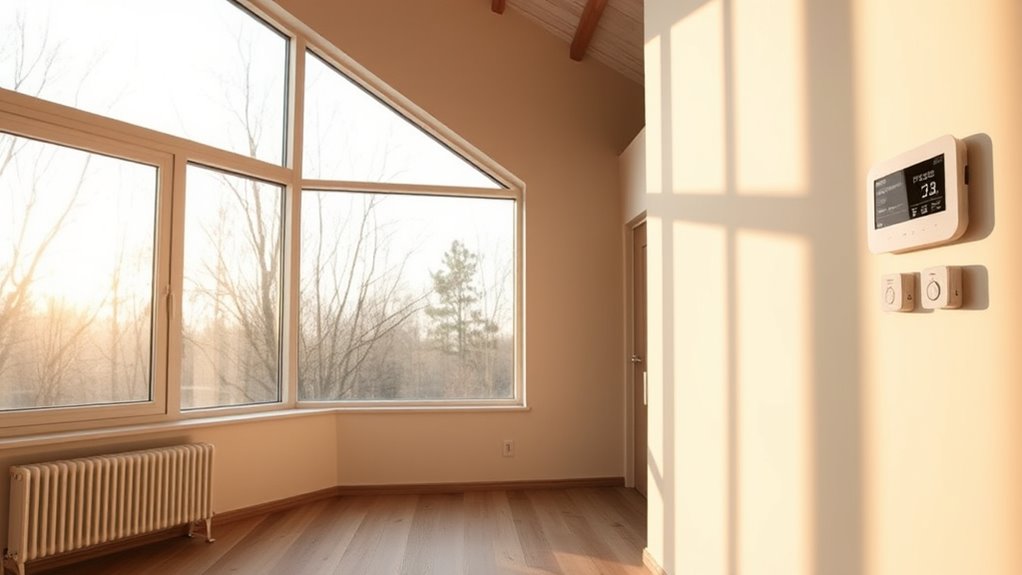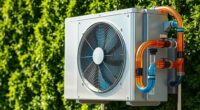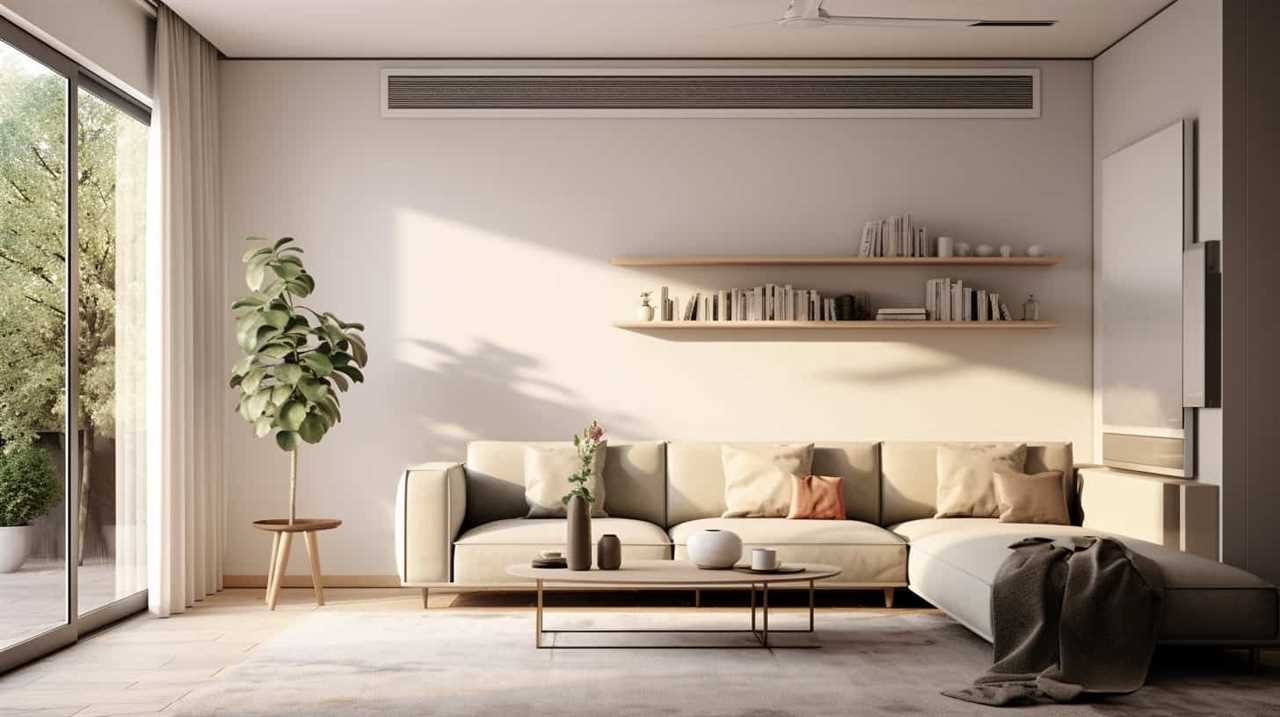In passive houses, climate control relies on airtight construction, high-quality insulation, and smart ventilation to maintain comfort efficiently. Pairing this with heat pumps helps transfer heat from the air or ground, reducing energy use and providing effective heating and cooling. Properly integrating these systems ensures ideal indoor conditions, humidity control, and energy savings. If you want to learn more about making your passive home’s climate control smart and sustainable, keep exploring these innovative solutions.
Key Takeaways
- Heat pumps efficiently transfer heat using phase change refrigerants, providing heating and cooling tailored to Passive House requirements.
- Proper insulation, airtightness, and thermal bridging considerations optimize heat pump performance and reduce energy consumption.
- Integration with ventilation systems and smart controls enhances indoor air quality, humidity, and overall climate management.
- Geothermal loops and renewable energy sources boost heat pump efficiency and sustainability in Passive House designs.
- Automated, adaptive systems ensure consistent comfort, energy savings, and minimal environmental impact in varying weather conditions.
Understanding Passive House Principles and Their Climate Needs
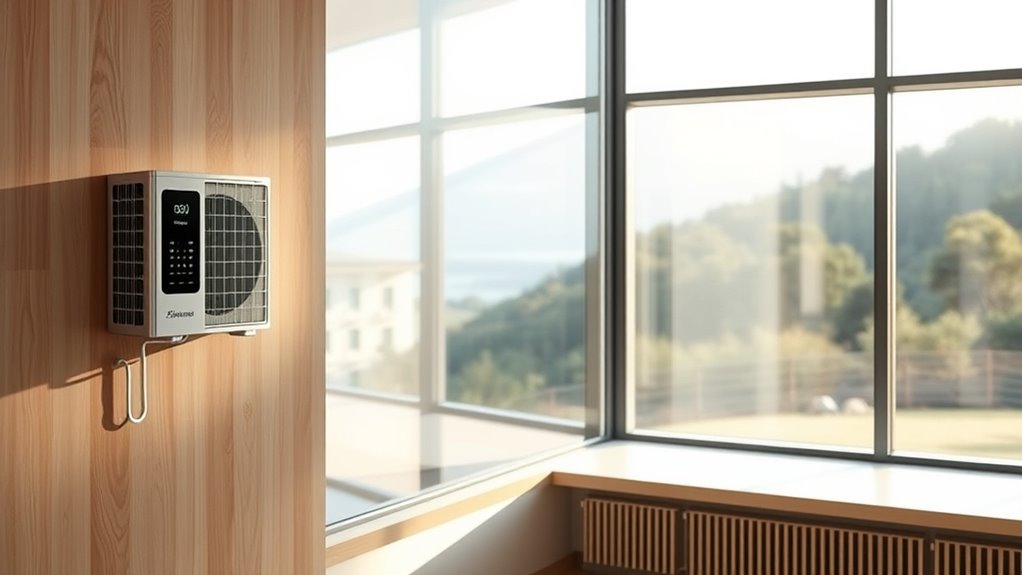
Understanding Passive House principles begins with recognizing their focus on energy efficiency and airtight construction. You’ll see that a well-designed thermal insulation system is essential, reducing heat loss and maintaining a consistent indoor climate. You can also optimize air exchange rates to improve indoor air quality while minimizing energy consumption. The airtight envelope seals the building, preventing drafts and uncontrolled air leaks, which are critical in minimizing energy use. These principles aim to create a building that naturally maintains comfortable temperatures with minimal active heating or cooling. Your goal is to design or select structures that optimize these elements, making them suitable for various climates. By prioritizing thermal insulation and airtightness, you guarantee your Passive House can handle weather fluctuations efficiently, reducing reliance on mechanical systems. Incorporating thermal bridging considerations further enhances energy performance by preventing heat transfer through building components. Additionally, employing effective ventilation strategies ensures a healthy indoor environment without compromising energy efficiency. Understanding climate-specific adaptations is essential for tailoring Passive House designs to different weather conditions, ensuring optimal performance across diverse environments. Recognizing the significance of passive heating and cooling techniques can also contribute to improved climate control, especially when integrated with renewable technologies like heat pumps.
How Heat Pumps Work in Sustainable Building Design
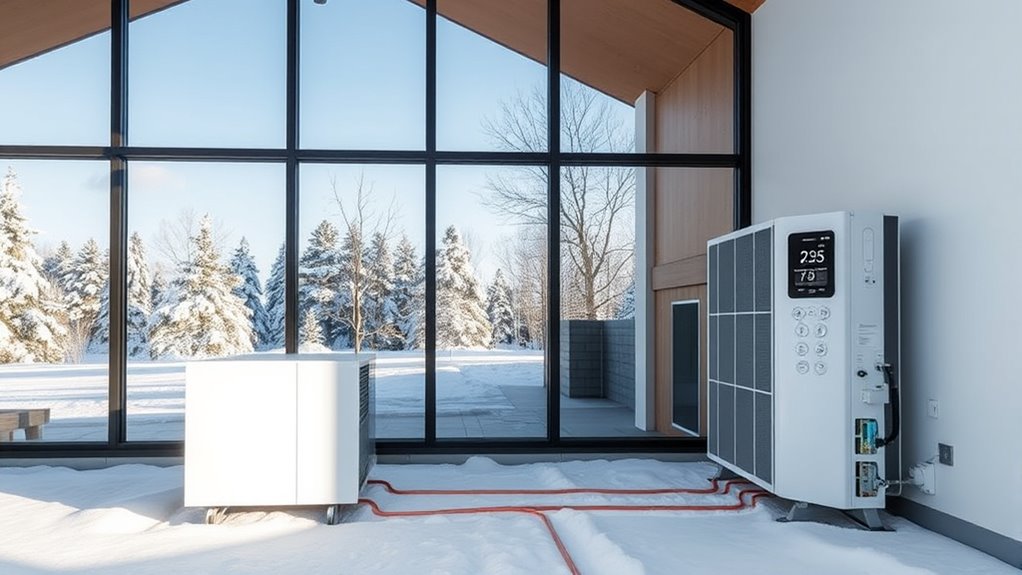
Heat pumps transfer heat by moving it from one place to another, even in cold weather, making them highly effective for sustainable building design. Their ability to utilize minimal energy for maximum output boosts overall efficiency. Understanding these mechanisms helps you maximize the climate control benefits in passive houses. Additionally, modern heat pumps incorporate advanced technology such as variable-speed compressors and smart thermostats, further enhancing their performance and energy savings. Incorporating energy-efficient systems can significantly reduce a building’s carbon footprint and operational costs. Moreover, the integration of renewable energy sources with heat pump technology can optimize sustainability and reduce reliance on fossil fuels. Furthermore, integrating passive house principles with heat pump technology optimizes energy use and indoor comfort. Support hours information can also be crucial when maintaining or troubleshooting these systems to ensure continuous operation.
Heat Transfer Mechanisms
How do heat pumps transfer thermal energy to maintain comfortable indoor temperatures in passive houses? They utilize three main heat transfer mechanisms: conduction, convection, and radiation. Conduction occurs when thermal energy moves through materials with high thermal conductivity, like walls or pipes. Convection currents help transfer heat through the movement of fluids or air, circulating warm air inside your home. Radiation transfers heat via electromagnetic waves, warming surfaces directly. Here’s a quick overview:
| Mechanism | Description |
|---|---|
| Conduction | Heat transfers through solid materials via thermal conductivity. |
| Convection currents | Warm air or fluid circulates, distributing heat evenly. |
| Radiation | Surfaces emit and absorb electromagnetic energy. |
| Conduction + Convection | Combined effect enhances heat distribution efficiency. |
| Heat pump role | Transfers heat using these mechanisms to regulate temperature. |
Additionally, heat pumps leverage phase change processes to efficiently transfer heat between indoors and outdoors, optimizing energy use in passive building designs. They often utilize refrigerants undergoing phase changes such as evaporation and condensation, which significantly improve heat transfer efficiency. This process allows for a higher coefficient of performance by minimizing energy loss during transfer. Furthermore, the effectiveness of these mechanisms depends on proper insulation and thermal conductivity of building materials, which enhances overall system performance. The integration of thermal management strategies is crucial for maximizing the efficiency of heat pumps in sustainable buildings.
Energy Efficiency Benefits
Because heat pumps transfer thermal energy efficiently, they considerably boost the energy performance of passive houses. By utilizing renewable energy sources, such as ambient air or ground heat, heat pumps reduce reliance on traditional fossil fuels, lowering overall energy consumption. Their high efficiency means you get more heating or cooling output for less electricity, saving you money in the long run. When combined with high-quality insulation materials, heat pumps maximize the building’s thermal retention, minimizing heat loss and reducing the need for additional energy input. This synergy enhances sustainability and makes passive houses even more energy-efficient. Additionally, the use of advanced technology in energy distribution ensures optimal operation and integration with renewable sources, further improving overall efficiency. Proper system design and regular maintenance also play crucial roles in maintaining peak performance and extending the lifespan of heat pumps. Incorporating smart controls can further optimize energy use and adapt to varying weather conditions. Ultimately, integrating heat pumps with renewable energy and superior insulation helps you create a comfortable, eco-friendly living space that’s both cost-effective and environmentally responsible.
Selecting the Right Heat Pump for a Passive House
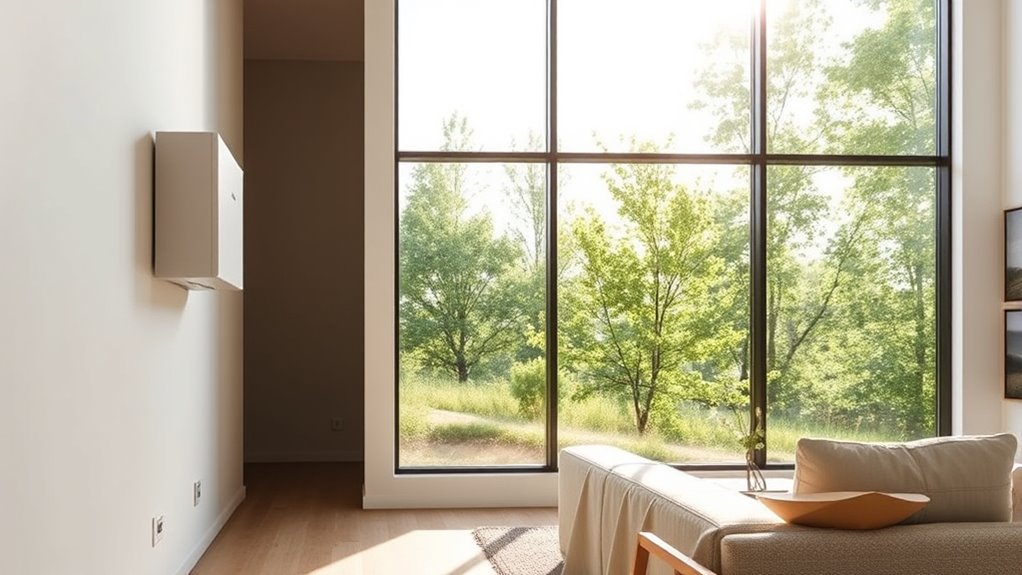
Choosing the right heat pump for a passive house starts with understanding your specific heating and cooling needs. Consider how solar shading and passive solar strategies influence indoor temperatures, reducing the load on your system. A well-designed passive house minimizes heat loss in winter and keeps interiors cool in summer, so select a heat pump with appropriate capacity and efficiency ratings. Look for models optimized for low-temperature operation, since passive houses often rely on minimal active heating. Additionally, think about whether a ducted or ductless system fits your layout best. Proper sizing is vital—an undersized unit won’t provide enough comfort, while an oversized one wastes energy. By considering your passive solar gains and shading strategies, you’ll guarantee your heat pump operates efficiently and keeps your home comfortable year-round.
Integrating Heat Pumps With Passive House Ventilation Systems
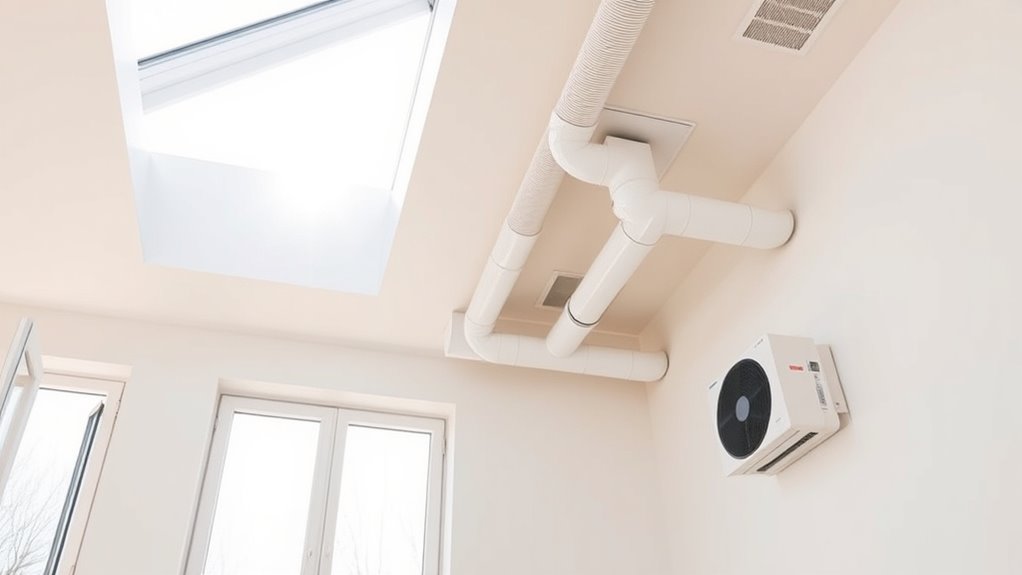
Integrating heat pumps with passive house ventilation systems guarantees your home operates efficiently and comfortably. When these systems work seamlessly together, you maximize heat exchange and reduce energy waste. This integration unlocks significant energy efficiency benefits that keep your home warm in winter and cool in summer.
Seamless System Integration
Have you ever wondered how heat pumps can work seamlessly with passive house ventilation systems? The key is smart integration through smart thermostats and zoning strategies. Smart thermostats allow you to control temperature zones precisely, ensuring each area maintains ideal comfort without wasting energy. When paired with advanced ventilation systems, they enable real-time adjustments based on indoor air quality, occupancy, and outdoor conditions. Zoning strategies help you direct conditioned air only where needed, reducing energy consumption and enhancing comfort. Properly integrating these components creates a unified system that responds dynamically to your home’s needs. This seamless coordination minimizes energy loss and maximizes efficiency, making your passive house more comfortable and cost-effective. Achieving harmony between heat pumps and ventilation is a crucial step toward sophisticated, low-energy climate control.
Optimized Heat Exchange
To maximize efficiency in passive houses, optimizing heat exchange between heat pumps and ventilation systems is essential. Integrating geothermal loops allows heat pumps to utilize the stable underground temperature, improving heat transfer. By coupling geothermal loops with refrigerant cycles, you enhance the system’s ability to extract or reject heat efficiently. This setup ensures that heat is transferred smoothly from the ventilation exhaust air to incoming fresh air, reducing energy consumption. Properly designed heat exchangers facilitate high-quality heat transfer, minimizing losses. When you optimize this process, the heat pump operates at peak efficiency, maintaining comfortable indoor temperatures with less energy. This integration not only boosts performance but also extends system lifespan, making passive houses even more sustainable and cost-effective.
Energy Efficiency Benefits
By combining heat pumps with passive house ventilation systems, you substantially boost overall energy efficiency. This integration minimizes energy waste by effectively transferring heat and maintaining consistent indoor temperatures. Utilizing renewable energy sources, like solar-powered heat pumps, further reduces your carbon footprint and lowers energy bills. Smart thermostats enhance this setup by allowing precise control over heating and cooling, optimizing performance based on occupancy and weather conditions. These systems work together to maximize energy savings without sacrificing comfort. As a result, your passive house becomes more sustainable and cost-effective. The synergy between heat pumps, passive ventilation, renewable energy, and smart thermostats creates a highly efficient climate control solution that aligns with eco-friendly goals. This approach ensures comfort while markedly reducing energy consumption.
Managing Heating and Cooling in Passive Homes Using Heat Pumps
Managing heating and cooling in passive homes with heat pumps requires careful system design and control strategies. You need to optimize thermal insulation to minimize heat loss in winter and heat gain in summer, ensuring consistent indoor temperatures. Solar shading plays a vital role in controlling heat from sunlight, reducing cooling loads during warmer months. Proper placement of shading devices, like overhangs or blinds, helps prevent overheating. A well-designed heat pump system adjusts output based on real-time data, maintaining comfort efficiently. Combining thermal insulation with strategic solar shading allows your heat pump to operate effectively, reducing energy consumption. By focusing on these elements, you create a balanced indoor environment that stays comfortable year-round, with minimal energy use and maximum efficiency.
Enhancing Indoor Comfort Through Humidity Control
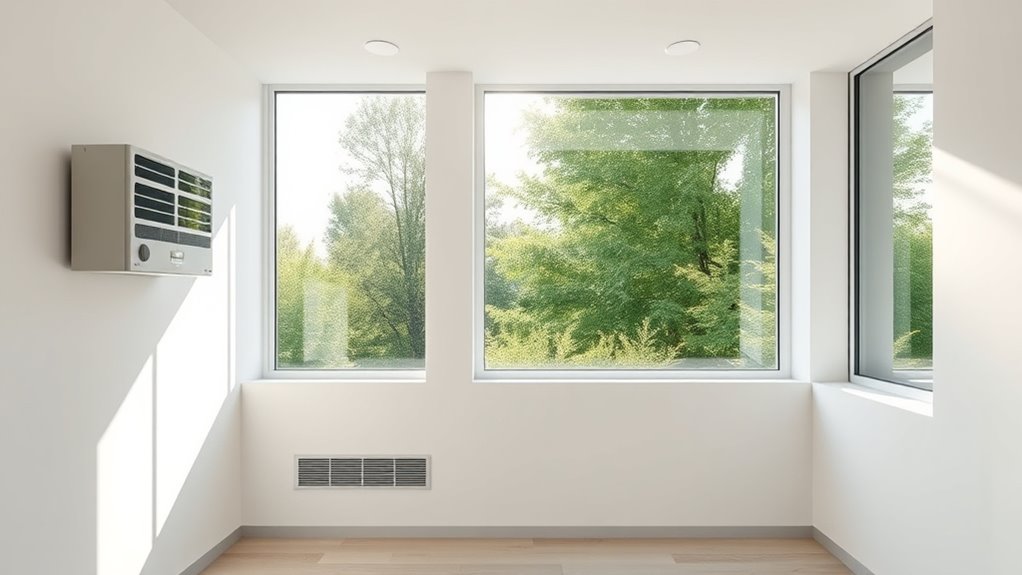
While heat pumps effectively regulate temperature, maintaining ideal indoor humidity levels is equally important for comfort. Proper humidity regulation prevents the air from becoming too dry or too moist, which can cause discomfort and health issues. In passive houses, controlling humidity improves indoor air quality by reducing mold growth, dust mites, and airborne pollutants. You can achieve ideal humidity by using systems that monitor and adjust moisture levels automatically. This ensures consistent comfort regardless of outdoor conditions. Humidity control also helps protect your home’s structure and furnishings from moisture damage. By focusing on indoor air quality through precise humidity regulation, you create a healthier, more comfortable living environment that enhances your overall well-being.
Efficiency Benefits of Using Heat Pumps in Passive Constructions
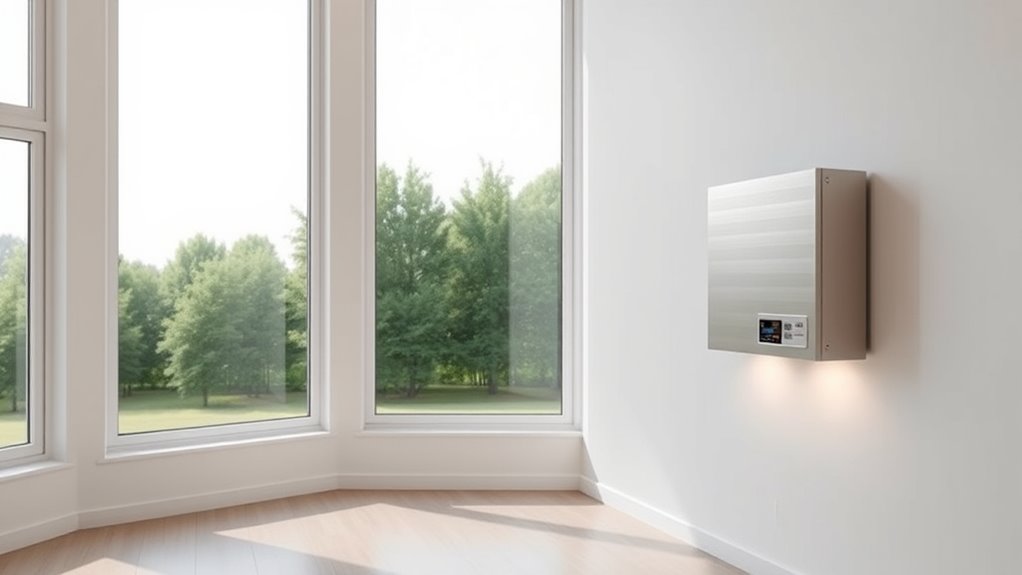
Heat pumps offer significant efficiency advantages when integrated into passive house designs, making them a smart choice for sustainable living. They harness minimal energy to provide effective heating and cooling, especially when combined with features like solar shading to reduce heat gain. Properly designed, passive buildings minimize thermal bridging, which otherwise causes heat loss and decreases efficiency. By addressing these factors, heat pumps operate more effectively, reducing energy bills and environmental impact. Consider how strategic placement of shading devices and insulation improves heat retention, maximizing the heat pump’s performance. The table below highlights key benefits:
| Benefit | How It Helps | Key Consideration |
|---|---|---|
| Reduced energy consumption | Less power needed for climate control | Minimize thermal bridging |
| Enhanced system lifespan | Less strain on components | Proper insulation |
| Lower carbon footprint | Less reliance on fossil fuels | Solar shading optimization |
Addressing Challenges and Common Concerns With Heat Pump Integration
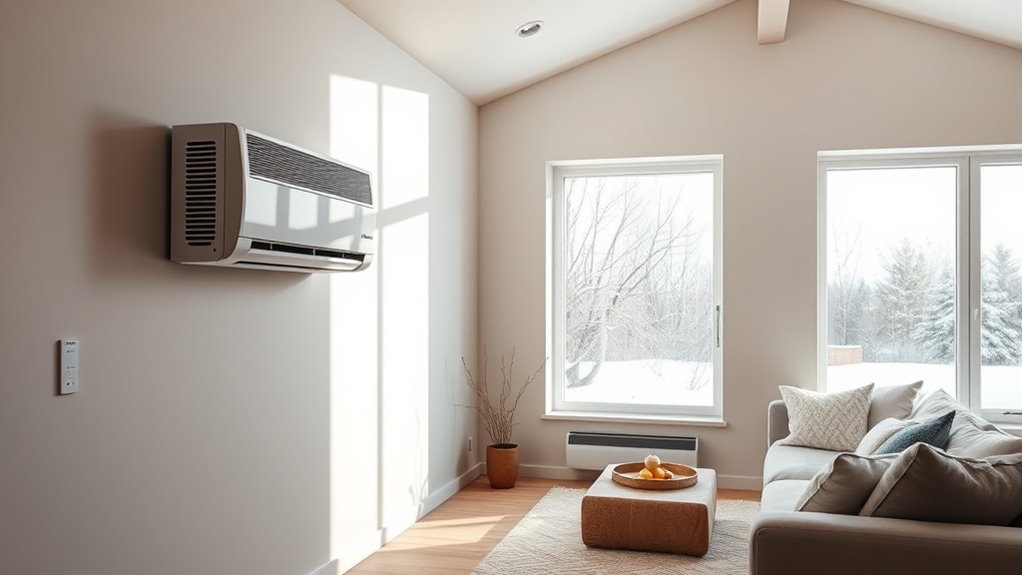
Integrating heat pumps into passive house designs can present several challenges that homeowners and builders need to address. One concern is ensuring proper building insulation, which is essential for maintaining consistent indoor temperatures and maximizing heat pump efficiency. Poor insulation can lead to temperature fluctuations and increased energy use. Additionally, solar shading plays a critical role in controlling heat gain during summer months, preventing overheating that can strain the heat pump’s capacity. Properly designed shading devices help keep indoor temperatures stable without compromising natural light. Addressing these challenges involves careful planning of insulation levels and solar shading strategies. When done correctly, these measures ensure your heat pump operates efficiently, providing reliable climate control while maintaining the passive house’s energy-saving goals.
Future Trends in Climate Control for Eco-Friendly Residences
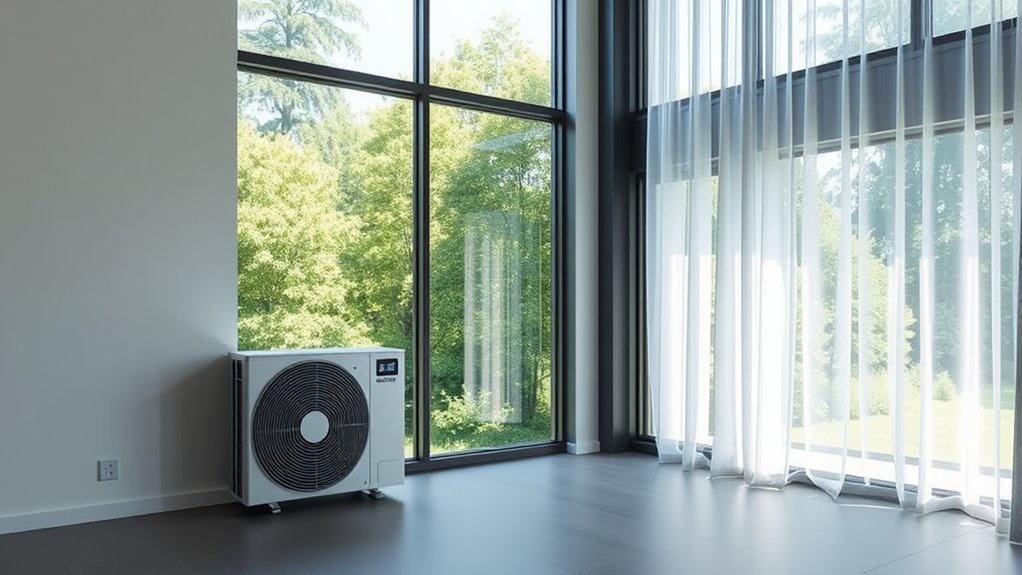
Advancements in technology and growing environmental awareness are shaping the future of climate control in eco-friendly homes. Expect smarter solutions that integrate solar shading systems to reduce heat gain and enhance comfort naturally. These systems will automatically adjust based on sunlight levels, minimizing reliance on active cooling. Additionally, indoor air quality will become a key focus, with innovations like advanced ventilation and air purification integrated into passive houses. This ensures healthier living environments without compromising energy efficiency. Future trends will also emphasize seamless automation, allowing you to optimize climate control effortlessly while maintaining sustainability. As these technologies evolve, you’ll enjoy increased comfort, lower energy bills, and a reduced ecological footprint—making eco-friendly residences more responsive, healthier, and easier to manage.
Frequently Asked Questions
How Do Heat Pumps Perform in Extremely Cold Climates?
In extremely cold climates, heat pumps still work well, but you need to take into account ground source efficiency and frost protection. Ground source heat pumps are more reliable because the ground stays warmer than the air, boosting efficiency. You should guarantee proper frost protection measures, like insulation and defrost cycles, so your system keeps running smoothly. With these precautions, heat pumps can effectively keep your home warm even in harsh winter conditions.
Can Heat Pumps Double as Cooling Systems in Summer?
You might think heat pumps only warm your home, but they actually excel at summer cooling too. Modern heat pump efficiency allows them to reverse and remove heat from inside, providing effective summer cooling. This dual functionality makes them a smart choice for year-round climate control. So, yes, heat pumps can double as cooling systems in summer, offering both comfort and efficiency with a single, versatile system.
What Maintenance Is Required for Heat Pumps in Passive Houses?
You should regularly check your heat pump’s filter maintenance and replace or clean filters every few months to guarantee efficient operation. Additionally, keep an eye on refrigerant levels and have a professional inspect and top them up if needed. Proper maintenance prevents breakdowns, maintains energy efficiency, and prolongs your system’s lifespan, making your passive house comfortable year-round with minimal hassle.
Are There Any Noise Concerns With Heat Pump Operation?
Imagine a quiet hum signaling comfort rather than disturbance. Heat pumps generally operate with low noise levels, but installation considerations matter. Proper placement away from bedrooms or outdoor living spaces can minimize sound impact. You might notice some noise during startup or defrost cycles, but modern units are designed to keep this subtle. With thoughtful installation, you won’t be kept awake—just cozy and quiet in your passive house.
How Do Heat Pumps Affect Overall Energy Savings in Passive Homes?
You’ll find that heat pumps considerably boost overall energy savings in passive homes by efficiently converting renewable energy into heating and cooling. They reduce reliance on traditional power sources, lowering your energy bills and carbon footprint. Plus, their use can improve indoor air quality by providing consistent ventilation and filtering indoor air. This combination of energy efficiency and better air quality makes heat pumps an excellent choice for maintaining a comfortable, eco-friendly home.
Conclusion
Just like Icarus aimed for the sun, you can reach new heights in comfort and efficiency by embracing heat pumps in your passive home. By understanding the principles and carefully integrating these systems, you’ll create a sanctuary that balances climate control with sustainability. With thoughtful planning, you’ll harness nature’s power—much like Da Vinci’s ingenuity—to build an eco-friendly retreat that’s both cozy and future-ready. Your journey toward greener living starts now.
